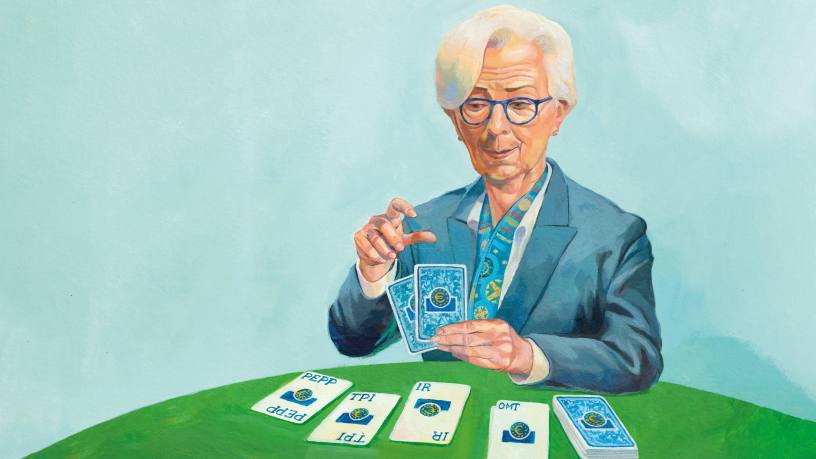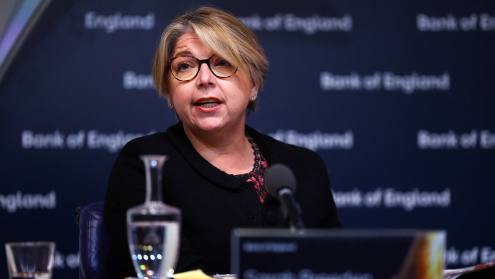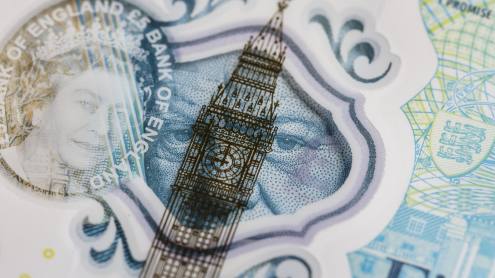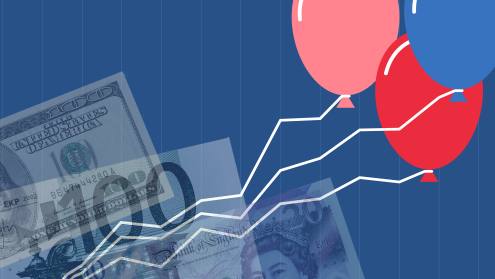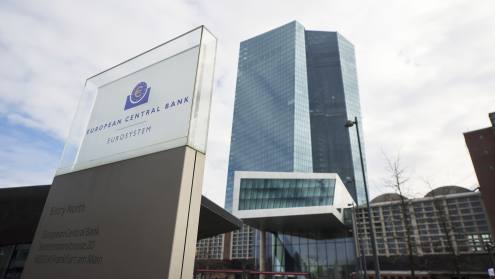When central banks embark on an aggressive rate-hiking cycle, despite the economy heading for a recession, it shows the extent of the situation facing the world.
On July 21, the European Central Bank (ECB) hiked its main deposit rate for the first time in more than a decade, with a 50-basis-point (bp) move to lift the eurozone and its banks out of a long and painful period of negative rates. The ECB followed up with another rate hike in September — this time with a punchy 75bp hike to take the rate to 0.75%. Further rate hikes are expected.
However, this is not a typical monetary policy tightening cycle in response to a buoyant economy. Far from that, the eurozone economy is heading for a recession that could last for some time. The rate hikes are simply there to counter the surging inflation in the eurozone caused by supply chain disruptions stemming from the Russian invasion of Ukraine and the Covid-19 pandemic.
For Europe’s banks, this creates quite a strange situation, where rising rates will provide a boost to their revenue, but where the benefits could also be wiped away by the underlying weakness of the eurozone economy.
Income boost
On their own, the rise in interest rates is a huge relief to Europe’s banks, which have frequently complained about the impact that negative rates have had on their profitability.
“Clearly, higher interest rates are a positive for European banks which are predominantly dependent on net interest income (NII),” says Elisabeth Rudman, head of European financial institutions group at global credit rating agency DBRS Morningstar. “It will mean NII will be higher, but it will unfold differently for different banks depending on the types of lending in their loan books, the timing of how their loan books reprice, and what proportion of their loans are floating or fixed.”
Commerzbank expects to see its NII increase by around €300m compared to last year, as a result of the ECB’s rate hikes. “The decision of the ECB to raise the deposit rate to zero is obviously a positive step for our deposit customers,” says Bettina Orlopp, chief financial officer (CFO) at Commerzbank, speaking before the ECB hiked rates for a second time in September. “The economic benefit for us is partially offset by the fact that we now no longer charge negative rates on deposits.”
However, Ms Orlopp warns that if rates rise to 1% or above, the bank could see some transfers out of current accounts and into interest-bearing accounts, which would reduce the benefit of rising rates to Commerzbank.
“As we were in a zero-to-negative interest rate environment for a considerable period of time and customers were — for the first time in history — confronted with negative rates on large deposits, it is hard to predict the future customer behaviour and the overall reaction of the banking system,” she says. “But it could well be that customers will be more conscious regarding interest on their deposits.”
Santander also expects to benefit to similar amount — around €300m to €400m — according to José García Cantera, the Spanish bank’s CFO. But that number could “exceed €1.5bn” next year, he adds.
Other banks that are more reliant on NII will benefit more from the rise in rates. Raiffeisen Bank International (RBI), for example, is expected to see its NII from jump from €3.3bn in 2021 to around €4.3bn-€4.7bn in 2022. “You have to bear in mind that RBI generates a very significant portion of its interest income in non-eurozone countries where very significant interest rate increases have already taken place,” says Johann Strobl, RBI’s chief executive.
Looming recession
The NII boost to banks could, however, be eliminated by the looming recession facing the eurozone, which will impact asset quality. The euro area economy grew by 0.6% in the first quarter before dropping to 0.5% in the second quarter.
“There are big differences between countries, with the real issue being Germany, which stands at 0% in the second quarter,” says Maria Demertzis, deputy director at Bruegel, a Brussels-based economic think tank. “If Germany goes into recession, it will drag the rest of Europe with it. Germany is the engine growth for Europe in many ways.”
Sandra Phlippen, chief economist at ABN Amro, says a recession in the eurozone is “practically unavoidable”. “The main question is how deep the recession will go and to what extent a downturn will put a break on further interest rate rises by the ECB,” says Ms Phlippen. “We think that the recession will last for the whole of 2023, but it could even be longer.
The main question is how deep the recession will go and to what extent a downturn will put a break on further interest rate rises by the ECB
“We don’t expect there to be a fast rebound, like there was after Covid, because back then nothing in the economy was really broken. Now, however, we’re dealing with a war that has led to a structural realignment of global commodity chains. On top of that, we have an energy crisis on our hands that requires us to fundamentally reorganise our energy supply system. Both these elements prevent a fast rebound.”
A recession will not only impact loan demand, but it will hit the the asset quality of existing loans, with banks having to take significant losses. “With regard to asset quality, this will have an impact on highly indebted borrowers, and this will lead to non-performing loan (NPL) ratios going up and a likely increase in provisions,” says Paul van der Westhuizen, a senior European bank strategist at Rabobank.
However, Mr van der Westhuizen adds the average NPL ratio for European banks is currently very low, at around 2.3%, so a spike is likely to be manageable. European banks have also got an array of tools in place for dealing with NPLs.
Increase in costs
The high inflation in the eurozone is another issue facing banks, adding to the costs and expenses. Euro-area inflation jumped from 8.9% in July to 9.1% in August.
“Though the consensus view says inflation is here to stay, the trajectory of inflation remains largely unpredictable in terms both of scale and duration,” says Philippe Brassac, CEO of Crédit Agricole. “But if the consensus does play out, then we — and all economic players — will have an issue for increasing our costs and expenses, the impacts of which will be difficult to pass on to our customer activities.”
He continues: “Concerning loan losses, their predictable rise stems not so much from inflation as it does from the normalisation of the cost of risk, a development that we foresaw in our 2025 medium-term plan. We had a long period of extremely low interest rates, which fell even lower, owing to ECB monetary intervention to counter the Covid crisis. This reduced the cost of risk to exceptionally low and clearly unsustainable levels. So, we are naturally seeing a logical increase in loan losses, the quantification of which remains the realm of hypotheses and forecasts at this point.”
Mr Cantera says Santander’s cost of risk this year will be approximately 1%, but he is confident about the bank’s ability to navigate through the storm.
“If we have a recession, then the risk of asset quality deterioration might outweigh the benefit of higher rates,” he adds. “But for Santander, we are in a better position than most other banks. Two-thirds of our portfolio is in secured lending such as mortgages and auto loans. Secondly, 40% of our business is in emerging markets, which is six-to-nine months ahead of developed economies in terms of the interest rate cycle. So, for Santander, we will have a net positive result from higher interest rates, despite some asset quality deterioration.”
Mr Cantera says that Santander is above the most relevant of its financial targets for the year. “We had a very good first half of the year with strong revenue growth. Commercial activity has been robust and we have captured new clients everywhere,” he says. “We brought in four million new customers in the first six months of the year. We achieved a 13.7% return on tangible equity, ahead of our full-year target to be above 13%.”
Commerzbank’s Ms Orlopp is also buoyant about the prospects for the rest of the year. “Despite ongoing headwinds from inflation, we are on track to reach our goal for operating expenses in 2022,” she says.
In the first half of the year, Commerzbank reduced its operating expenses to below €2.9bn, which included headcount reductions, branch closures and decreasing the use of external consultants. The bank also more than doubled its operating profit and expects higher revenues than last year for the current financial year.
ECB late to the party
Despite the ECB embarking on an aggressive rate hiking spree, and the introduction of an anti-fragmentation tool to curb eurozone periphery spreads, the ECB has faced a lot of criticism for not having acted sooner on tackling the spiralling rate of inflation.
However, Mr Strobl says that “the recent statements in Jackson Hole [Economic Symposium] make me positive that inflation will now be fought decisively”.
At the Jackson Hole gathering at the end of August, Isabel Schnabel, a member of the executive board of the ECB, delivered a speech calling on central banks “to act forcefully” to tackle the “uncomfortably high” levels of inflation.
However, acting forcefully is not something everyone at the ECB agrees with. Speaking at an event in Barcelona on August 29, the ECB’s chief economist, Philip Lane, said it was better to raise rates in smaller increments. Analysts believe that while this would allow the ECB to assess the economy better, it would risk the ECB falling further behind in the rate hiking cycle to tackle inflation.
Interest rates may be increasing, but they are not increasing fast enough as inflationary pressures are mostly supply driven
As Ms Demertzis points out: “Interest rates may be increasing, but they are not increasing fast enough as inflationary pressures are mostly supply driven.” In real terms, interest rates will remain very low. The ECB is also likely to put a pause on a rate hikes early next year due to the upcoming recession.
Mr Brassac says the ECB “needs to take into account the inevitable repercussions of its policy on the sustainability of sovereign debt, with debt remaining at uniformly high levels across eurozone countries”.
“In this respect, the announcement of an anti-fragmentation tool is clearly a major contribution by the ECB,” he adds. “In an environment that is both highly unpredictable and extremely restrictive, the central bank is required to find the best way to move forward in a progressive manner, which is a particularly delicate task.”
He is referring to the Transmission Protection Instrument (TPI), under which the ECB will be able to purchase eurozone countries’ bonds under certain conditions, which was also introduced on July 21. The central bank also has other tools at hand to address fragmentation risks, including the Pandemic Emergency Purchase Programme and the Outright Monetary Transactions Programme.
Uncertainty ahead
Higher interest rates are a positive in boosting NII, but then there is high inflation and a looming recession which could eat up the benefits of that. There are a lot of unknowns and subsequently it is difficult to predict how badly banks would be affected.
“Excluding the first few months of the pandemic, bank valuations in Europe are trading at the lowest level in years,” says Mr Cantera of Santander. “The market is finding it difficult to assess the impact of the combination of these variables.”
Commerzbank’s Ms Orlopp agrees that there is uncertainty ahead. “The economic risks are significant,” she says. “An end to the war in Ukraine is not foreseeable; inflation is at the highest in many decades and global supply chain problems are being resolved … very slowly. But the most difficult and urgent question is the one dealing with the further supply with natural gas. The threat of shortages in natural gas supply has the potential to drag Germany and Europe into recession.” Despite this, she says that Commerzbank is well positioned to deal with these challenges, thanks to its comfortable capital base and conservative risk provisioning.
The war in Ukraine is the main concern for RBI’s Mr Strobl. “We hope for a peaceful solution, but at the same time we are preparing for an aggravation of the situation,” he says. “For example, as part of our proactive risk policy, we have already formed gas supply shock overlays in the second quarter.”
The threat of shortages in natural gas supply has the potential to drag Germany and Europe into recession
RBI has been one of most affected banks from the war in Ukraine due its strong footprint in Russia and Ukraine. The bank’s subsidiaries in the countries contributed 42% of the group’s 2021 profits, with just under 35% of its total net profit coming from its Russia operations, according to Moody’s.
“However, so far RBI has showed very strong resilience as it has strong earnings capacities and a proactive risk management approach,” says Mr Strobl.
Crédit Agricole’s Mr Brassac is also confident that the French bank has the tools required to deal with the challenges ahead. “We need to pick up the relay from the collective measures of governments to support [our customers] in an environment that will remain unpredictable but, in theory, more difficult than the recent period,” he says.
“We have the strengths to fulfil this mission, owing to our size, solidity and diversified business lines, and to our business model, combining at local level universality — in that we provide each customer with a comprehensive range of services as part of a global approach — and usefulness, as our activities are focused on the real needs of our customers and society.”
Ms Phlippen says the recession and losses that banks will have to incur are the main challenges for European banks. But she adds that there are no signs currently indicating that banks will not be able to handle this.
Mr van der Westhuizen adds: “The impact on banks will depend on the length of this inflation situation and what the ECB does in response. Also, although a recession is highly likely, the question is how long and deep the recession is going to be.
“I don’t think it will be very long or deep as the fundamentals underpinning economies look quite solid,” he continues. “Banks are going to benefit from tailwinds, such as higher NII, however they are facing elevated funding costs, which will impact banks that are more dependent on wholesale funding than deposits. Volatility in debt and equity markets is also expected to continue in the short term, but this can be a positive or a negative for trading desks.”



